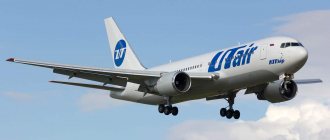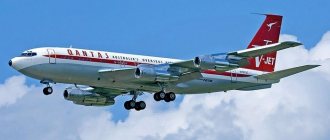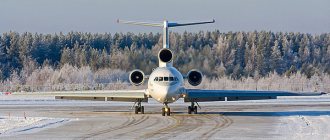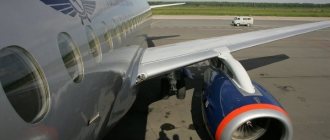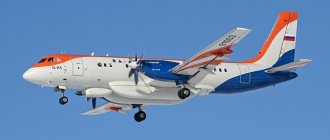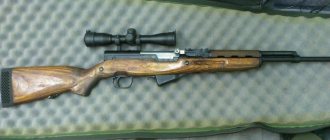| IL-96 | |
| Type: | Passenger plane |
| Developer: | OKB Ilyushin |
| Manufacturer: | VASO |
| Chief designer: | Genrikh Novozhilov |
| First flight: | 1988 |
| Start of operation: | 1993 |
| Status: | Operated |
| Main operators: | Aeroflot (6 aircraft) “Special flight squad “Russia” (4 aircraft, 2 ordered) Flight (3 aircraft, 3 ordered) |
| Years of production: | 1993 - present V. |
| Units produced: | 25 (6 under construction) |
| Unit cost: | $58 million |
| Base model: | IL-86 |
Il-96 is a wide-body passenger aircraft for medium and long-haul airlines, designed at the Ilyushin Design Bureau in the late 1980s. It made its first flight in 1988 and has been in serial production since 1993 at the Voronezh Joint-Stock Aircraft Manufacturing Company plant. Il-96 became the first and last Soviet long-range wide-body aircraft.
History of creation
By the mid-1970s, almost all long-haul air transportation in the USSR and socialist countries was carried out on Il-62 aircraft. However, the capabilities of these aircraft could not fully respond to the rapid growth in the volume of long-distance transportation: due to the relatively low passenger capacity, the number of flights increased, and accordingly, the load on airports increased. In addition, the cabin of the narrow-body aircraft was far from the degree of comfort that was achieved on the Boeing 747, which entered service in 1969, which became the world's first wide-body aircraft.
In 1974-1977, simultaneously with the development of the Il-86 aircraft at the Design Bureau named after. S.V. Ilyushin conducted research on the long-range aircraft Il-86D. This aircraft differed from the original in increased wing dimensions (470 sq.m.) and new turbojet engines with a higher bypass ratio, reduced specific fuel consumption and a thrust of 20,850 kgf. Research at the Central Aerohydrodynamic Institute named after. N. E. Zhukovsky showed that through the use of new technical solutions it is possible to significantly improve the fuel efficiency of the Il-86D aircraft and increase its weight efficiency. It was assumed that complete unification with the Il-86 would allow the aircraft to be quickly certified and put into service.
In 1978, using the results of work on the Il-86D project, the OKB began developing the Il-96 aircraft with a T-shaped tail, a higher aspect ratio wing with supercritical nose profiles and an area of up to 387 sq.m. Research on this option was carried out until 1983, when the progress achieved in the field of aviation science and technology made it possible to abandon the idea of creating the Il-96 aircraft using many ready-made units and systems of the Il-86 aircraft in its design and move on to creating a fundamentally new Il-96 aircraft. 96-300.
The Il-96-300 aircraft differs from its predecessor Il-86 by having a fuselage shortened by 5.5 meters, a larger wing span and a reduced sweep angle, increased dimensions of the vertical tail, and an improved interior of the passenger cabin. New alloys are used in its design and the proportion of composite materials is increased. The aircraft uses an automatic fuel consumption control system, which allows it to maintain the alignment of the aircraft in flight. Particular attention was paid to the reliability and safety of aircraft operation. The aircraft uses a Russian digital avionics complex with six color multifunction displays, an electronic thrust control system, an inertial navigation system and satellite navigation aids. It was decided to install new Solovyov PS-90A engines on the Il-96-300. The smooth nacelle of the PS-90A, uncharacteristic of the dual-circuit engines previously produced in the USSR, increased the fuel efficiency of the aircraft.
The set of requirements presented to the Ilyushin Design Bureau by the Ministry of Civil Aviation - transportation of a commercial load of 30 and 15 tons over a practical range of 9000 and 11,000 km with a cruising speed of 850 to 900 km/h at an altitude of 9,000 to 12,000 m - made the traditional one the optimal aerodynamic design: four-engine cantilever low-wing aircraft with vertical tail. The T-tail was abandoned. The IL-96-300 was initially created as an aircraft with development potential: its design allows for the relatively fast and inexpensive development of various modifications of the aircraft.
A further development of the Il-96-300 aircraft was the creation of the Il-96M variant, in which many US aviation companies took part. The fuselage of the aircraft was extended to 64 meters, that is, even more than on the Il-86. But the main distinguishing feature of the Il-96M was the Pratt&Whitney PW2337 engines. The prototype was created on the basis of the first prototype Il-96-300. The plane took off on April 6, 1993, but was not put into mass production. On the basis of the Il-96M, the cargo Il-96T was created, which was also assembled in a single copy. A double-deck version of the Il-96-550, equipped with an NK-92 turbofan engine (4 x 20,000 kgf) and designed to carry 550 passengers, was also studied.
In 1999-2000, work was carried out on the project of the Il-96-400T cargo aircraft, which has the capabilities of the Il-96T cargo aircraft, but has Russian PS-90A-2 turbofan engines and on-board equipment. It made its first flight on May 16, 1997. In operation since 2009.
Tests
The first prototype (no. 96000) was assembled directly at the design bureau workshop on Leningradsky Prospekt in Moscow. At the beginning of September 1988, the plane was solemnly rolled out of the assembly shop. The experimental Il-96-300 aircraft performed its first flight on September 28 from the Frunze Central Airfield on Khodynskoye Field. The plane was piloted by a crew under the command of Stanislav Bliznyuk, Honored Test Pilot of the USSR, Hero of the Soviet Union. The flight directly over the central regions of Moscow lasted 40 minutes.
During testing, the Il-96 performed several remarkable long-range flights, including Moscow-Petropavlovsk-Kamchatsky-Moscow without landing in Petropavlovsk. The plane covered 14,800 km in 18 hours and 9 minutes. On June 9, 1992, an Il-96 flew from Moscow to Portland via the North Pole, spending 15 hours in the air. The aircraft was tested in Yakutsk at -50°C and in Tashkent at +40°C. Based on the test results, on December 29, 1992, the aircraft was awarded an airworthiness certificate. For six months, the new cars were “tested” on Aeroflot routes, and due to lack of funding, operational tests had to be combined with commercial cargo transportation. The work of the Ilyushin Design Bureau team on the Il-96-300 was awarded the State Prize of the Russian Federation.
Aircraft Ilyushin Il-96 - registry
| type | head n. | s/n | p/p | onboard | operator | status | noticed | * | |||||||||||
| Il-96 prototypes produced by MMZ Strela | |||||||||||||||||||
| Il-96M | 0101 | 01-01 | 1988 | RA-96000 | KB Ilyushin (Aviation complex) | cut | 10-15 years (f) First flight Il-96-300. The first flight on September 28, 1988 was performed by a crew under the command of the Honored Test Pilot of the USSR, Hero of the Soviet Union Stanislav Bliznyuk. The flight over the central regions of Moscow lasted 40 minutes. In 1993, it was converted into an Il-96M prototype by inserting into the fuselage, replacing engines (PW-2037, for which the pylons were replaced), avionics, and cutting off the keel (by ~1m). Parsed into LII | ||||||||||||
| Il-96-300 | 0102 | 01-02 | KB Ilyushin (Aviation complex) | etc. tests | 7-10 years (f) Prototype for strength testing. Any clarifications are interesting (it is known that two machines were made for testing - one at VASO, the other at MMZ. Where - which one?)! One of the two boards was at TsAGI, in the so-called “pool”. Another was tested at MMZ named after. Ilyushin (Khodynskoe field). During testing, the right console was broken. Disassembled, cabin preserved. | ||||||||||||||
| Il-96-300 | 0103 | 01-03 | 1989 | RA-96001 | KB Ilyushin (Aviation complex) | cut | 10-15 years (f) Second flight Il-96-300. For a long time it was stored in Zhukovsky without engines. Disassembled in LII. | ||||||||||||
| serial Il-96-300 produced by VASO | |||||||||||||||||||
| Il-96-300 | 74393201001 | 001 | 1990 | RA-96002 / Igor Gudkov | KB Ilyushin (Aviation complex) | in storage | 3-6 years (f) The third flight prototype of the Il-96-300, the first Il-96 produced by VASO. The aircraft is flying under a test flight program. Also carried out commercial cargo transportation under the flag of Atlant-Soyuz and Aerostars. | ||||||||||||
| Il-96-300 | 74393201002 | 002 | 1991 | RA-96005 | Aeroflot - Russian Airlines | in storage | 3-6 years (f) Le Bourget'1991. The first production IL-96. Until 1994 - operational tests under the Aeroflot flag. In the early 90s, I flew with the inscription “Russia”. In March'2004 it was repainted in new Aeroflot colors. 22B/234Ek | ||||||||||||
| Il-96-300 | 74393201003 | 003 | 1992 | RA-96006 | Domodedovo Airlines - DAL (AirUnion) | in storage | 6-12 months (f) Not in operation after the bankruptcy of DAL on 10.2008. The story will be updated as information becomes available. Owner: Birless Ltd. | ||||||||||||
| Il-96-300 | 74393201004 | 004 | 1992 | 96007 | KB Ilyushin (Aviation complex) | flies | 6-12 months (f) In April'2005, repainted in new Aeroflot colors. 22B/234Ek | ||||||||||||
| Il-96-300 | 74393201005 | 005 | 1993 | CU-T1717 / Yakov Moiseev | Cubana de Aviacion | in storage | 3-6 years (f) In November'2005, repainted in new Aeroflot colors. The aircraft took part in tests and made a record flight lasting 18 hours 09 meters (14840 km). 22B/234Ek | ||||||||||||
| Il-96-300 | 74393201006 | 006 | 1994 | RA-96009 | Domodedovo Airlines - DAL (AirUnion) | in storage | 3-6 years (f) Not in operation after the bankruptcy of DAL on 10.2008. The story will be updated as information becomes available. Owner: Birless Ltd. 2016 - the aircraft was delivered near the Domodedovo ATB for ferrying to Ramenskoye in the interests of Aviastar-Tu. 10/09/2017 deregistered =>registry experiment. aviation. 12/13/17 — flight to Zhukovsky. | ||||||||||||
| Il-96-300 | 74393201007 | 007 | 1994 | RA-96010 / Nikolay Karpeev | Aeroflot - Russian Airlines | cut | 3-6 years (f) In February'2005, repainted in new Aeroflot colors. Named "Nikolai Karpeev". On June 3, 2014, an aircraft caught fire in the parking lot at Sheremetyevo airport. 22B/234Ek | ||||||||||||
| Il-96-300 | 74393201008 | 008 | 1994 | RA-96011 / V. Kokkinaki | Aeroflot - Russian Airlines | in storage | 3-6 years (f) In May'2005, repainted in new Aeroflot colors. 22B/234Ek | ||||||||||||
| Il-96-300 | — | — | RA-96012 | — | — | ||||||||||||||
| Il-96-300 | — | — | RA-96016 | — | — | ||||||||||||||
| Il-96-300 | — | — | RA-96017 | — | — | ||||||||||||||
| Il-96-300 | 74393202012 | 012 | 1995 | RA-96015 / M. Gromov | Aeroflot - Russian Airlines | in storage | 1-2 years (f) In April'2005 repainted in new colors of Aeroflot 22B/234Ek | ||||||||||||
| Il-96-300 | 74393202013 | 013 | 1999 | RA-96013 | Domodedovo Airlines - DAL (AirUnion) | in storage | 1-2 years (f) Initially, airborne 96013 was intended for the second Il-96-300PU (now it is RA-96016). Not in use after the bankruptcy of DAL on 10.2008. The story will be updated as information becomes available. Owner: Birless Ltd. | ||||||||||||
| Il-96-300 | — | — | RA-96014 | — | — | ||||||||||||||
| Il-96-300 | 74393202015 | 015 | 2005 | CU-T1250 | Cubana de Aviacion | flies | the day before yesterday (r) 18B/244Ek | ||||||||||||
| Il-96-300 | 74393202016 | 016 | 2006 | CU-T1251 | Cubana de Aviacion | flies | 6-12 months (r) 18B/244Ek | ||||||||||||
| Il-96-300 | 74393202017 | 017 | 2006 | CU-T1254 | Cubana de Aviacion | flies | 3-6 years (f) 18B/244Ek | ||||||||||||
| Il-96-300 | — | — | RA-96018 | — | — | ||||||||||||||
| Il-96-300 | — | — | RA-96019 | — | — | ||||||||||||||
| Il-96-300 | — | — | RA-96020 | — | — | ||||||||||||||
| Il-96-300 | — | — | RA-96021 | — | — | ||||||||||||||
| Il-96-300 | — | — | RA-96022 | — | — | ||||||||||||||
| Il-96-300 | — | — | RA-96023 | — | — | ||||||||||||||
| Il-96-300 | 74393203024 ? | 024 | 2021 | RA-96024 | VASO | flies | 3-4 weeks (r) IL-96-300PU. 10.2016 - fuselage assembled. For SLO. | ||||||||||||
| Il-96-300 | 74393203025 ? | 025 | 2021 | RA-96025 | VASO | flies | 3-6 months (f) Il-96-300 for SLO. Tests. | ||||||||||||
| serial Il-96-400 produced by VASO | |||||||||||||||||||
| Il-96-400T | 97693201001 | 101 | 1997 | RA-96101 / Vyacheslav Salikov | Flight AK (Voronezh) | in storage | 3-6 years (f) The aircraft was built as a prototype of the Il-96T with PW-2337 engines (serial number was indicated as 74393201101). In 2004-07, converted to Il-96-400T with PS-90A1 engines (assigned new serial number 97693201001). Took part in test flights. Delivery to Atlant-Soyuz was planned (the board was repainted in the aircraft livery), but A-S refused the cargo division. Delivery to AFL-Cargo was planned, but fell through in 2008 due to the bankruptcy of the company. Delivery to flight in April 2009. First commercial flight - September 25, 2009. Financial leasing from IFC. Operating hours from 2009.09 to 2010.05 - 909 hours. In June 2013, it arrived at VASO; it is planned to convert it into a passenger version for the Cubana airline. | ||||||||||||
| Il-96-400 | — | — | RA-96102 | — | — | ||||||||||||||
| Il-96-400T | 97693201003 | 103 | 2009 | RA-96103 / Stanislav Bliznyuk | VASO | in storage | 3-6 years (f) Financial leasing from IFC. In June 2013, it arrived at VASO; it is planned to convert it into a passenger version for the Cubana aircraft (according to another version, into the Il-96-400TZ). | ||||||||||||
| Il-96-400 | — | — | RA-96104 | — | — | ||||||||||||||
| Il-96-400T | 97693201005 | 105 | RA-96105 | VASO | under construction/construction | 7-10 years (f) Initially planned delivery to Atlant-Soyuz in 2009. Delivery to Polyot in 2012. | |||||||||||||
| Il-96-400T | 97693201006 ? | 106 | RA-96106 ? | under construction/construction | In 2010, it entered production. | ||||||||||||||
| Il-96-400T | 97693201007 ? | 107 | RA-96107 ? | under construction/construction | In 2010, it entered production. | ||||||||||||||
| experimental Il-96-400M produced by VASO | |||||||||||||||||||
| Il-96-400M | 01001 | 00-01 | KB Ilyushin (Aviation complex) | under construction/construction | The first experimental Il-96-400M. The slipway assembly is underway in 2022. March 2022 - F1 is manufactured. https://aviaforum.ru/proxy.php?image=https%3A%2F%2Fpp.userapi.com%2Fc844520%2Fv844520938%2F1d8af3%2FGiTSkd_2aRk.jpg&hash=0bb725f8313b56f97ff0d30b76d54aa9 According to plans for 2 022 year. https://bloknot-voronezh.ru/thumb/900x0xcut/upload/iblock/540/9cf/1.jpg | ||||||||||||||
| Operator: USSR - MAP status: | closed |
| date of foundation: | 1939.01.11 |
| closing date: | 1991.12.01 |
| codes: | IATA: - ICAO: - ext: |
comments:
| January 11, 1939 By the Decree of the Presidium of the Supreme Soviet of the USSR “On the division of the People's Commissariat of Defense Industry of the USSR”, the People's Commissariat of Aviation Industry (NKAP) of the USSR was formed from the First (aircraft) Directorate of the People's Commissariat of Defense Industry of the USSR on March 15, 1946. — The Ministry of Aviation Industry of the USSR is a Union-Republican ministry that managed the aviation industry in the Soviet Union. March 15, 1953 merged with the Ministry of Armaments of the USSR into one - the Ministry of Defense Industry of the USSR. It was re-established by the Decree of the Presidium of the Supreme Soviet of the USSR of August 24, 1953. December 14, 1957 abolished. On its basis, the State Committee of the Council of Ministers of the USSR on aviation technology was created. Formed for the third time on March 2, 1965. on the basis of the State Committee for Aviation Technology of the USSR. Abolished by the Decree of the USSR State Council of November 14, 1991, ceased its activities on December 1, 1991. |
| Operator: Ilyushin Design Bureau (Aviation Complex) status: | active |
| date of foundation: | 1991.12.24 |
| based on: | USSR - MAP → KB im. S. V. Ilyushina (MAP) |
| codes: | IATA: - ICAO: - ext: |
comments:
| December 24, 1991 Moscow Machine-Building Plant named after S.V. Ilyushin, according to Order No. 4 of the Department of Aviation Industry, was renamed into Open Joint Stock Company named after S.V. Ilyushin. |
| Operator: Aeroflot - Russian Airlines status: | active |
| date of foundation: | 1992 |
| based on: | Aeroflot - MGA USSR → Central Administration of MVS |
| codes: | IATA: SU ICAO: AFL ext: SU |
comments:
| Public Joint Stock Company "Aeroflot - Russian Airlines" OJSC "Aeroflot - Russian Airlines". A320-214 (68), A-321-211 (28), A-330-243 (5), A-330-343 (17), B-737-8LJ (19), B777-3MOER (15), RRJ-95B (30) |
| Operator: Domodedovo Airlines - DAL (AirUnion) status: | closed |
| date of foundation: | 1992 |
| closing date: | 2009.02 |
| based on: | Aeroflot - MGA USSR → Domodedovo PA GA |
| codes: | IATA: E3 ICAO: DMO ext: E3 |
comments:
| SE No. 4 - Domodedovo Civil Aviation Production Association - issued 07/01/1992. Canceled on 06/04/1998 due to the transformation from a PA to an OJSC. SE No. 4 - Avia JSC - issued 06/04/1998. 1) By the decision of the FAVT no. 12/VD dated 02/03/09, the SE was canceled 2) The order of the FAVT dated 10/23/2008 no. GK-174-r the validity of the operator’s certificate is suspended from 11/01/2008. Regular flights for August 2006: Domestic - Anadyr, Blagoveshchensk, Vladivostok, Krasnoyarsk, Magadan, Norilsk, Petropavlovsk-Kamchatsky, Khabarovsk, Yuzhno-Sakhalinsk, Yakutsk. International - Baku, Ganja, Karaganda, Kustanay, Samarkand, Tashkent. The company was part of the AirUnion alliance (KrasAir, DAL, Samara, SIAT, Omskavia). |
| Operator: Russia (GTK) status: | active |
| date of foundation: | 1992 |
| based on: | Aeroflot - MGA USSR → 235th Separate Government JSC |
| codes: | IATA: FV ICAO: SDM ext: P4, PL |
comments:
| Joint Stock Company "Avia Federal State Unitary Enterprise" State Transport Since 02/11/2011 - OJSC "Avia". The company was founded in 1992 on the basis of the 235th separate aviation squadron (government). In 2006, merged with Pulkovo airline. In 2008, the government aviation squadron was allocated as an independent operator - SLO Rossiya. |
| Operator: Phoenix (Sheremetyevo) status: | closed |
| date of foundation: | 1997 |
| closing date: | 2002 |
| codes: | IATA: - ICAO: - ext: |
comments:
| CJSC "Aviatsionnaya" |
| Operator: Moscow (Atlant-Soyuz) status: | closed |
| date of foundation: | 1993.06.08 |
| closing date: | 2011.01.15 |
| based on: | Atlant-SV (Ukraine) |
| codes: | IATA: 7B ICAO: MOA internal: ShchV, 7B |
comments:
| Aviation OJSC In 2010, Atlant-Soyuz was renamed into Moscow airline. |
| Operator: VASO status: | active |
| date of foundation: | 1992 |
| based on: | USSR - MAP → VASO (MAP) |
| codes: | IATA: - ICAO: - ext: |
| Operator: Cubana de Aviacion status: | active |
| date of foundation: | 1929 |
| codes: | IATA: CU ICAO: CUB ext: |
comments:
| Empresa Consolidada Cubana de Aviación Compañia Nacional Cubana de Aviación Curtiss Cuban National Aviation Company |
| Operator: Polet AK (Voronezh) status: | closed |
| date of foundation: | 1988 |
| closing date: | 2015 |
| codes: | IATA: YQ ICAO: POT ext: software |
comments:
| Founded on August 9, 1988, back in Soviet times; Thus, Polet is the first private airline in Russia. SE No. 14 - Aviation CJSC issued on 05/18/1994. By order of the Federal Air Transport Agency dated March 25, 2015 No. 162, the SE was canceled. SE No. AON-08-05-028 - Aviation CJSC - issued 04/27/2005. Suspended when? SE AR - valid for 2016. An-2 (2) |
| Operator: Russia - SLO status: | active |
| date of foundation: | 2008.08 |
| based on: | Russia (GTK) |
| codes: | IATA: — ICAO: RSD ext: LR |
comments:
| Federal State Budgetary Institution “Special Flight Detachment “Russia” of the Administration of the President of the Russian Federation. The company was founded in 1992 on the basis of the 235th separate aviation squadron (government). In 2006, it was merged with the airline and carried out regular passenger transportation from Pulkovo and Vnukovo airports. In 2008, the government aviation squadron was allocated as an independent operator - SLO Rossiya. |
| Operator: Aerostarz status: | closed |
| date of foundation: | 1997.10.10 |
| closing date: | 2011.11 |
| codes: | IATA: PL ICAO: ASE ext: DO |
comments:
| LLC "Avia" In October 2011, the SE was canceled by the Federal Air Transport Agency in connection with a presidential decree (based on the inspection report dated October 28, 2011, i.e. the inspection “took place” after the cancellation of the SE). |
| Operator: Russia (USSR) - Air Force status: | active |
| date of foundation: | 1910 |
| codes: | IATA: - ICAO: RFF ext: |
comments:
| This virtual airline also includes other military, departmental, government aircraft, whose affiliation is unknown. |
| Operator: KB im. S. V. Ilyushin (MAP) status: | closed |
| date of foundation: | 1933.01.13 |
| closing date: | 1993 |
| includes: | USSR - MAP |
| codes: | IATA: - ICAO: - ext: |
comments:
| On January 13, 1933, on the basis of order No. 411 of the Deputy People's Commissar of Heavy Industry of the USSR and the Head of the Main Directorate of the Aviation Industry, Comrade. P.I. Baranov about the organization at plant No. 39 named after. V.R. Menzhinsky, a design bureau for experimental aircraft construction of light aircraft and military series was formed to organize a closed cycle of aircraft design and production. |
Statistics by year of release Statistics by
| 1988 | 89 | 90 | 91 | 92 | 93 | 94 | 95 | 96 | 97 | 98 | 99 | 2000 | 01 | 02 | 03 | 04 | 05 | 06 | 07 | 08 | 09 | 10 | 11 | 12 | 13 | 14 | 15 | 16 | 17 | 18 | 19 | 20 | 2021 | Total | order/assembly |
| released | 1 | 2 | 1 | 1 | 2 | 1 | 3 | 2 | 1 | 1 | 1 | 2 | 1 | 2 | 2 | 2 | 1 | 1 | 1 | 1 | 1 | 2 | 32 | 4 | |||||||||||
| in operation | 1 | 1 | 2 | 1 | 2 | 2 | 1 | 1 | 1 | 1 | 1 | 1 | 2 | 17 |
Operator statistics
| → | operator | exploited | order/assembly | in storage | dismantled | during all this time |
| 1 | Russia - SLO | 10 | 1 | 11 | ||
| 2 | Cubana de Aviacion | 3 | 1 | 4 | ||
| 3 | VASO | 2 | 1 | 1 | 10 | |
| 4 | KB Ilyushin (Aviation complex) | 1 | 1 | 1 | 2 | 10 |
| 5 | Russia (USSR) - Air Force | 1 | 1 | |||
| 6 | Aeroflot - Russian Airlines | 3 | 1 | 7 | ||
| 7 | Domodedovo Airlines - DAL (AirUnion) | 3 | 5 | |||
| 8 | Flight AK (Voronezh) | 1 | 3 | |||
| 9 | Russia (GTK) | 6 | ||||
| → | 10 | USSR - MAP | 4 | |||
| → | # | → KB im. S. V. Ilyushina (MAP) | 4 | |||
| 11 | Aerostarz | 1 | ||||
| 12 | Moscow (Atlant-Soyuz) | 1 | ||||
| 13 | Phoenix (Sheremetyevo) | 1 |
Statistics on traffic to this registry Statistics on this registry Views of this registry: 119935, of which today: 18
Notes on the registry Registries russianplanes.net
are compiled on the basis of media reports, analysis of photographs and schedules, data permitted for publication from operators, aircraft factories, design bureaus, from the Economic Archive, as well as on the basis of additions sent by site visitors, , , .
The project administration is not responsible for possible inaccuracies and irrelevance of the information provided.
Exploitation
The aircraft has been produced since 1992 at the Voronezh Aviation Plant. Since 1988, 23 aircraft of this type have been built. As of August 2009, 16 aircraft are in operation (13 in Russia). Of these, 6 Aeroflot airliners are used for passenger transportation.
According to the decision of the Ministry of Civil Aviation of the USSR, adopted at a board meeting on January 26, 1989, the first Il-96 aircraft were planned to be transferred to the TsUMVS (Central Directorate of International Air Services) of Aeroflot, then to the Domodedovo air squad. Retraining of the flight personnel took place at the Ilyushin Design Bureau. The first flight squad was organized on August 6, 1991. In 1992, several technical flights were carried out from Moscow to Petropavlovsk-Kamchatsky and Yuzhno-Sakhalinsk.
Commercial operation of the aircraft began on July 14, 1993 on the Moscow-New York route. At first, the aircraft was used mainly on foreign flights: to Singapore, Las Palmas, New York, Tel Aviv, Palma de Mallorca, Tokyo, Bangkok, Los Angeles, San Francisco, Seattle, Rio de Janeiro, Buenos Aires, Seoul, Sao Paulo, Havana, Hanoi, Santiago, Lima. All Il-96 aircraft currently flying at Aeroflot were assembled in the first half of the 1990s. In exchange for reducing duties on the import of foreign equipment, Aeroflot undertook to purchase an additional batch of Il-96s, but the deal never took place, although duties were reduced.
Two aircraft were built to serve the President of the Russian Federation (modification Il-96-300PU, b/n RA-96012, RA-96016).
In 2005-2006, three Il-96-300s were delivered to Cuba, including one to serve the President of Cuba. In 2009, the Venezuelan government entered into a contract for the supply of two Il-96-300s - one for passenger transport, the other for VIP transport.
In the fall of 2008, the IFC leasing corporation seized two Il-96-300s from Krasnoyarsk Airlines due to the company's insolvency. The aircraft are currently in storage. In the history of Russian aviation, this was the first time that an airline had airplanes. It is these two Il-96-300s that are being considered for transfer to Venezuela.
In 2009, Polet Airlines began operating Il-96-400T cargo aircraft, which Aeroflot initially planned to buy, but later abandoned them. As of September 2009, Polet airline has three Il-96-400T aircraft with a plan to receive three more aircraft in 2010. Also, during the MAKS-2009 aerospace salon, an agreement was signed with a Peruvian airline for the supply of two Il-96-400T freighters with an option for another such aircraft, and negotiations are underway on its delivery to China and the countries of the Middle East. The current version of the aircraft is equipped with new engines and the most modern Russian-made flight and navigation system, which allows the aircraft to be operated without any restrictions around the world. Such aircraft have not yet been produced in Russia. Il-96-400T can transport up to 92 tons of cargo on medium and long-distance routes. The aircraft is certified in accordance with Russian airworthiness standards, harmonized with the standards of the European Union and the USA.
At various times, negotiations were held on the sale of Il-96 to China (three aircraft), Syria (three aircraft) and even Zimbabwe. In 2007, KrasAir airline planned to transfer two of its Il-96s to Iran Air on a “wet lease” for a year.
The first two prototypes (nos. 96000 and 96001), stored for a long time at the Gromov Flight Research Institute in Ramenskoye, were destroyed in May 2009. Another 5 aircraft (2 KrasAir and 3 Domodedovo Airlines) are temporarily taken out of service and are in storage.
In 2009, Minister of Industry and Trade Viktor Khristenko decided to discontinue production of the Il-96-300 passenger aircraft in the coming years, since the airliner is not able to compete with the latest long-haul passenger aircraft from Boeing and Airbus. The creators of the Il-96-300 were guided by the economic performance of the Boeing 767, however, since the first flight of the Il-96-300, new-generation long-haul airliners Boeing 777, Airbus A330, Airbus A340, Airbus A380 have been put into operation, and the Boeing 787 and Airbus A380 are expected to enter the market soon. Airbus A350. By 2012, two more Il-96-300 will be produced for the Rossiya SLO (including the presidential Il-96-300PU). The cargo version of the Il-96-400T aircraft remains in production.
| Operator | Modification | Quantity |
| They fly | ||
| Aeroflot | Il-96-300 | 6 |
| Cubana de Aviacion | Il-96-300 | 3 |
| Aerostarz | Il-96-300 | 1 |
| Special flight squad "Russia" | Il-96-300 Il-96-300PU | 3 2 |
| Flight | Il-96-400T | 3 |
| In storage | ||
| Domodedovo Airlines | Il-96-300 | 3 |
| Krasnoyarsk Airlines | Il-96-300 | 1 |
| Dismantled for scrap | ||
| KB Ilyushin | Il-96-300 Il-96-400M/T | 1 1 |
| Under construction | ||
| Special flight squad "Russia" | Il-96-300PU | 2 |
| Flight | Il-96-400T | 3 |
Il-96 in commercial operation
This aircraft entered commercial operation only in the summer of 1993; the first flight was from Russia to the USA. At the first stages of use, this unit carried out international flights around the globe, and then began to serve flights within our country. In domestic transportation, it connected Russian cities over both long and short distances. In 2005-2006, the Ilys began to be exported abroad, namely, three cars were sold to Cuba, one of them was of the presidential class. Nowadays, domestic airlines widely use the Il-96 to transport their passengers. Also, some companies have cargo models of vehicles in their hangars.
The most widely used airlines in our country are two airlines, as well as Cubana. The IL-96 has a big advantage over long distances because it is more spacious and comfortable for passengers than its narrow-body counterparts. Passengers themselves talk about the advantages of this model over all others.
Unfortunately, this airliner could not achieve very great popularity due to its high price and rather high fuel consumption, this was also influenced by other economic factors. At the beginning of 2009, aircraft designers raised the issue of removing the Il-96 aircraft from mass production. This problem arose mainly due to the high competition of foreign models of passenger aircraft.
Aircraft design
Glider
The IL-96 is designed according to the design of an all-metal cantilever four-engine wide-body low-wing aircraft with a swept wing and vertical tail.
The Il-96-300 fuselage has the same diameter as the Il-86 fuselage, but is 5.23 meters shorter in length due to the reduced number of rows of passenger seats. However, the design of the fuselage has been significantly changed to increase its reliability, ensure safety in the event of damage, reduce the rate of crack growth, ensure a given service life, reduce weight and improve the quality of the outer surface. The various layouts of the passenger compartment provide a capacity from 235 to 300 people. On a standard aircraft (300 seats), the seats are installed in two salons (front - 66 seats and rear - 234 seats) with a pitch of 870 mm, nine in a row with three aisles 550 mm wide. The layout for 235 seats provides for passengers to be accommodated in three cabins: in first class - in 22 seats with a pitch of 1020 mm, in business class - in 40 seats and in economy class - in 173. The passenger cabin is equipped with refreshment counters and 8 toilets.
There are three cargo compartments on the lower deck. The front one can accommodate 6 standard cargo containers of the ABK-1.5 type, the rear one - ten, while the maximum load of the aircraft involves occupying only nine containers, while the other seven can be used for transporting cargo and mail. The third cargo compartment is designed for the transportation of piece goods.
The wing on the Il-96 is significantly different from those installed on the Il-86. The wingspan is more than 60 meters, and the area is 391 m²: 70 meters more than the IL-86. Distinctive features of the wing are large vertical tips with a height of 3.1 m. Wing
The IL-96 has complex takeoff and landing mechanization, consisting of double-slotted flaps and slats along the entire length of the leading edge.
The horizontal tail of the IL-96 is the same as that of the IL-86, and the area of the vertical tail has increased due to an increase in its height by one and a half meters. The need to increase the area of the vertical tail is due to the requirement to ensure directional stability in the event of failure of one engine.
The IL-96 chassis consists of three main supports located under the center section and a front support. Each of the three supports is equipped with a four-wheel trolley with brake wheels, and the front support has two non-braking wheels. All fourteen wheels have the same dimensions 1300*480 mm and a tire pressure of 11.5 kg/cm².
Power point
The IL-96 is equipped with four turbofan engines with a high (4.5) bypass ratio PS-90A with a thrust at maximum engine operating mode of 16,000 kgf, which are attached to the wings on pylons. Thrust in cruising mode - 3500 kgf. Specific fuel consumption in cruising mode is 0.595 kg/kgf·hour. Made using a two-shaft system, there is a reversing device. The fan is single-stage, the compressor is 13-stage. The high-pressure turbine is two-stage, the low-pressure turbine is four-stage. PS-90A has a modular design, the number of modules is 11. They can be replaced during operation.
For the first time in the history of Soviet aviation, the engine is equipped with a two-channel electronic control and parameter monitoring system “Diagnoz-90”. Among the advantages of the system are automatic control of fuel consumption and surge protection. An air launch is provided at an altitude of up to 7,000 meters.
The engine was certified in 1992 (April 3), as was the aircraft. At the end of 2006, the Il-96-300 aircraft with the PS-90A engine received a certificate for compliance with Chapter 4 of the ICAO noise standards.
Aircraft systems
The Il-96 used an advanced flight navigation system for its time, thanks to which the aircraft became the first of the Il-s designed to be controlled by a crew of three (without a navigator), as well as the first Soviet aircraft equipped with an electronic flight control system VSUP -85-4. In addition to the traditional analog indicators on the instrument panel (“alarm clocks”), displays on beam tubes were added: two each for the commander and co-pilot (complex flight indicator and complex navigation situation indicator) and two more on the central panel (engine parameter indicators). The aircraft is equipped with a fly-by-wire control system (EDCS).
The aircraft's fuel system was developed on the basis of the IL-86 fuel system. It works automatically, but for emergency situations there is a manual control mechanism. The fuel is located in nine caisson tanks, of which four are located in the console of each of the wings and another one in the center section. Kerosene is pumped from the tank by jet pumps into the pre-flow compartment, and then into the supply compartment, separate for each of the four engines.
The air conditioning system (ACS) of the IL-96 also operates automatically. SKV blocks are located in the center section. Air enters the cabin from the engines. Taking into account repeated circulation when the aircraft is fully loaded (300 passengers), the SCV pumps 25.7 kg of air per passenger per hour into the cabin.
A cyclic electric pulse anti-icing system protects the leading edges of the wings and stabilizers, as well as the fin. It is interesting that heating is not provided on the inner section of the leading edge of the wing (from the center section to the nearside engine pylon) and on the “toe” of the fin, which is explained by the insignificant influence of icing in these places on the controllability of the aircraft. The engine air intakes are heated using air taken from the compressor chamber.
Options
Il-96-300
Basic version with PS-90A engines (4x16,000 kgf). The aircraft made its first flight on September 28, 1988, and received an airworthiness certificate on December 29, 1992. The first Il-96-300 entered service with Aeroflot in 1993. Currently, in addition to Aeroflot, only State Customs Committee Russia is used as VIP transport and Cuban Cubana, including as transport for the President of Cuba. It was mass-produced at the VASO plant in Voronezh. The only passenger aircraft of the series in service. 20 aircraft were produced, including prototypes. On August 11, 2009, it was announced that the Il-96-300 aircraft would be withdrawn from production as “unpromising.”
Maximum take-off weight is 250 tons, payload is 40 tons. Flight range at maximum load is 9,000 km, with a number of passengers of 269 people and with a full supply of fuel - 13,500 km. Passenger capacity in a three-class cabin is 235 people, in a two-class layout - 262, in economy class - 300 people.
Il-96-300PU
A special version of the Il-96-300, designed to transport the President of the Russian Federation. Il-96-300PU (Control Post) was built in two copies. There are practically no differences in flight performance from the basic version, except for the increased range due to some modifications. The aircraft is equipped with equipment that allows it to control armed forces in the event of a nuclear conflict. Externally, the aircraft also does not differ from the basic version, with the exception of the characteristic chute in the upper part of the fuselage. The first aircraft of this version was assembled in 1995 for Boris Yeltsin. The second, “Putinsky” Il-96 (b/n 96016) took off on April 21, 2003.
Il-96M/T
Il-96M is the first Russian aircraft developed in collaboration with Western companies. Only one prototype was made. In March 1993, the fuselage of the experimental Il-96-300 was lengthened, the PS-90 engines were replaced with Pratt&Whitney PW2337 (for the first time in the history of Russian aviation, American engines were installed on an aircraft) with a thrust of 17,030 kgf, and Western avionics were installed. The aircraft made its first flight on April 6, 1993. In 1997, the Il-96M was certified in the USA. It was repeatedly demonstrated at various air shows, at MAKS-2003 it was demonstrated under the designation Il-96-400 with NK-86 engines. In May 2009 it was cut up.
In all major indicators, the Il-96M became a “record holder” among Soviet passenger aircraft: it is capable of carrying up to 435 passengers, the maximum payload is 58 tons, the maximum take-off weight is 270 tons, and the practical flight range is 12,800 km.
Other options have been developed:
- Il-96MD is an aircraft powered by two Pratt&Whitney PW4082 engines (these engines are currently used on the Boeing 777).
- Il-96MK is an aircraft with four NK-92 turbojet engines with a thrust of 20,000 kgf.
Based on the Il-96M, a cargo version of the Il-96T . In 1997, a single copy was built (nominal number RA-96101), and took off on May 16. It was also repeatedly demonstrated at air shows in Aeroflot’s signature livery, although the airline never used it and there were no orders for this type.
Il-96-400
Il-96-400 aircraft is a deep modernization of the Il-96-300 with PS-90A-1 engines with a thrust of 17,400 kgf and improved avionics. The fuselage was “borrowed” from the Il-96M. Maximum take-off weight is 270 tons, payload is 58 tons. Maximum passenger capacity is 435 people. The maximum flight range is 13,000 km.
As of 2009, the Il-96-400 had not been assembled in a single copy, and there were no orders for this type yet.
Il-96-400T
Il-96-400T is a cargo version of the Il-96-400. Flight performance indicators remained unchanged. Produced at the VASO plant in Voronezh. The first Il-96-400T was created by reconstructing the Il-96T, assembled in 1997. In 2007, an entirely new aircraft was assembled. Both aircraft were sold to Atlant-Soyuz in 2007, and in 2009 they were transferred to Polyot. As of May 2011, three aircraft are successfully operating in the Poleta fleet, and two more will be put into operation in 2011.
History of the creation of IL-96 and its modifications
The designers began developing a new aircraft model in 1978. The new development was based on the existing domestic long-range aircraft Il-86D. The designers used the IL-86 as a basis right up until 1983, until advanced technologies began to appear, which forced the creators to reconsider the project and use more advanced materials and technologies. The designers were faced with the fact that the units and parts they had developed were no longer relevant, and the global aircraft industry had stepped far forward.
For these reasons, the designers had to retreat from their plans and develop a fundamentally new machine, which was the basis for all subsequent modifications of the new Il-96 machine. The new Il-96 first took off from the ground in October 1988, and already in 1989 it was presented in Paris at the world air show. During the testing process, Il carried out many tests, the main one being long-range flight. Based on the new car, many new modifications were created that were more specialized.
The Il-96-400 modification was improved compared to the base model, as it increased engine power and the number of seats for passengers. A cargo model of Ila was also created, which is actively used in our time. Even more progressive was the Il-96M model, which was developed jointly with US airlines. But this model currently exists in one copy and is used only for presentation at air exhibitions around the world. As for the standard IL-96 model, it entered mass production only in 1993.
Flight performance
| Characteristic | Il-96-300 | Il-96M/T | Il-96-400M/T |
| First flight | September 28, 1988 | April 6, 1993 | May 16, 1997 |
| Start of operation | July 14, 1993 | — | April 23, 2009 |
| Wingspan | 57.66 m | 60.105 m | 60.105 m |
| Length | 55.345 m | 63.939 m | 63.939 m |
| Height at tail | 17.55 m | 15.717 m | 15.717 m |
| Wing area | 350 m² | 391.6 m² | 391.6 m² |
| Payload | 40,000 kg | 58,000 kg | 58,000 kg |
| Max. take-off weight | 250,000 kg | 270,000 kg | 265,000 kg |
| Max. passenger capacity | 300 | 436 | 436 |
| Crew | 3 | 3 | 3 |
| Cruising speed | 870 km/h | 870 km/h | 870 km/h |
| Maximum speed | 910 km/h | 900 km/h | 900 km/h |
| Operational ceiling | 12,000 m | 12,000 m | 12,000 m |
| Flight range (at maximum load) | 9,000 km | 12,800 km | 10,000 km |
| Engines | 4x PS-90A | 4x Pratt&Whitney PW2337 | 4x PS-90A-1 |
Accidents and incidents
In the entire history of operation of the Il-96 aircraft, there have been no disasters or accidents that resulted in the death of people.
Incident during takeoff of the presidential plane
On October 5, 2004, some Russian publications reported that on September 29, while taking off from Lisbon International Airport, an Il-96-300PU (c/n 96016) collided with a flock of birds, presumably pigeons. Bird strikes are a common occurrence in aviation, which, however, does not always lead to engine failure. The takeoff was aborted and the plane was towed to the parking lot. On September 30, it was inspected by technicians from the State Customs Committee of Russia, which owns the plane, who arrived from Moscow on an Il-62.
As a result, it was announced that the reason for the cancellation of the takeoff was not a collision with birds, but condensation from the SCR tubes that got onto the dashboard. Moisture distorted the instrument readings: the engines were operating in takeoff mode, but the instruments showed that the engines were unable to reach takeoff mode. Probably, this incident would have remained ordinary if the attention of the Russian press had not been attracted by a photograph of the Portuguese spotter Miguel Claudio, who was lucky enough to photograph the plane at the time of the incident.
Putin was not on the plane at that moment; he was in Saratov.
Flight ban
On August 2, 2005, the same Il-96-300PU, but with the president on board, was unable to take off from the airport in the Finnish city of Turku, where Vladimir Putin was on an official visit. During taxiing, a certain technical malfunction was discovered, and it was decided to transfer the president to the reserve Il-62.
The consequences of this incident were more serious. On August 22, at the proposal of the Federal Service for Supervision of Transport, flights of all Il-96 aircraft were prohibited. This was explained by a systematic failure of the wheel braking system, which also occurred on August 2 in Finland. It was announced that one of the wheel brake units, UG151-7, was defective and did not correspond to the stated drawings. UG151 units for the Il-96 were assembled at the Balashikha Foundry and Mechanical Plant; to replace them, a new batch was assembled at the NPO Molniya plant in Moscow.
The ban resulted in multimillion-dollar losses for airlines that used the Il-96, primarily Aeroflot. On October 3, VASO General Director Vyacheslav Salikov was dismissed, and Il-96 flights were resumed on the same day. The flight ban lasted 42 days.
Named aircraft
Some Il-96 aircraft bear the names of outstanding Soviet pilots and figures in aviation and astronautics.
- Il-96-300 RA-96005: “V. Chkalov"
- Il-96-300 RA-96007: “A. Mayorov"
- IL-96-300 RA-96008: “I am. Moiseev"
- Il-96-300 RA-96010: “N. Karpeev"
- Il-96-300 RA-96011: “V. Kokkinaki"
- Il-96-300 RA-96014: "Mikhail Vodopyanov"
- Il-96-300 RA-96015: “M. Gromov"
- Il-96-300 RA-96017: "Mikhail Reshetnev"
- Il-96-400T RA-96101: “Vyacheslav Salikov”
- Il-96-400T RA-96102: “Valery Menitsky”
- Il-96-400T RA-96103: “Stanislav Bliznyuk”
Other facts
- Il-96 is the second in Soviet history (after Il-86), the first in Russian history (produced since 1992, that is, after the collapse of the Soviet Union) and the ninth wide-body aircraft in the history of world aviation.
- In September 2008, one of the PS-90A engines, assembled in 1990 and installed on the Aeroflot Il-96-300 aircraft, for the first time in the history of Russian aviation, exceeded the operational milestone of 30,000 hours.
- The IL-96 is one of the few wide-body aircraft that has never suffered a crash resulting in loss of life. This number also includes the most modern airliners from foreign manufacturers: Boeing 777, Airbus A380 and Airbus A340; however, accidents and incidents still occurred with the latter. Il-96, despite the slow pace of production and the relatively small number of aircraft produced, remains one of the most reliable airliners in the world.
- The empty weight of the Il-96-300 is 117 tons, it is 62 times heavier than the 105th Volga, 16 times heavier than the Ural-4320 army truck, 9 times heavier than the Ikarus-280, 3.5 times heavier than a metro car, and at the same time, the aircraft is 6 tons lighter than the ChME3 diesel locomotive.
- The wing area of the Il-96M is one and a half times larger than the area of a tennis court.
Where is the Il-96 passenger aircraft used?
Il-96 is a long-range aircraft that carries passengers. This aircraft model is capable of long-distance flights without landing. The main task of this model was to replace narrow-body aircraft that were used on flights both within the country and abroad. Before the creation of the new Il-96, all passenger transportation was carried out by the old Il-62 and Il-86. The need for a new wide-body aircraft grew every year, as the number of passengers who wanted to use airline services began to actively grow. Also, aircraft that had a wide fuselage could provide more comfortable flying conditions for customers.

